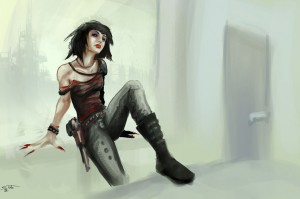In her book, The Feminine Mystique, Betty Friedan argued that women were expected to “find fulfillment only in sexual passivity, male domination, and nurturing maternal love” (2001, p. 92). This view was perpetuated by “stories and articles that showed women as either happy housewives or unhappy, neurotic careerists, thus creating the ‘feminine mystique’” (“Feminine Mystique”). Friedan sought to dismantle such notions.
For women to achieve self-actualization, she argued, they would have to find meaning outside of the domestic sphere. Although Friedan probably wouldn’t have condoned murder, Molly has constructed a meaningful identity for herself while emphatically upending the “feminine mystique” in her job as a bodyguard/mercenary. I believe this makes her a feminist symbol.
In this post, I want to make the case that Gibson has dropped clues to indicate that he intended Molly to be a symbol of female empowerment. Actually, much of what I’m about to say is just a summary of all the great points that everyone has made during class discussions about her. Of those points, I want to focus on the most salient: Molly’s features and her interactions with Riviera.
It’s all in the eyes
The feature that sets Molly apart are the silver glasses surgically grafted onto her skin. Many people said that her lenses denied outsiders access to her emotions and closed the “windows to her soul.” They’re basically her mirrorshades which, as Bruce Sterling explains, “prevent the forces of normalcy from realizing that one is crazed and possibly dangerous” (ix). They give Molly an air of mystery and danger–both of which are warranted by her actions.
In short, she’s cool, detached, and positively lethal. These are all traditionally masculine characteristics. Gibson even turns a potentially vulnerable and feminine act (crying) into an aggressive act of contempt, thus endowing her with a sort of vulgar masculinity.
So isn’t occupying a traditionally male role (e.g. the killer body guard) empowering or even feminist? Or is she just a femme fatale?
I don’t think she is.
Wikipedia defines a femme fatale as “a mysterious and seductive woman whose charms ensnare her lovers in bonds of irresistible desire, often leading them into compromising, dangerous, and deadly situations” (Dellamora).
Although Molly uses sex to get what she wants, she doesn’t do it in a way that would qualify her as a femme fatale. She makes a calculated decision to sell her body as a puppet so that she can afford the modifications (namely, the lenses, razors, and enhanced reflexes) that will allow her to pursue a fulfilling career. Although in both cases, the men are a means to an end, Molly does not use seduction or charm to entice her johns or cause them harm. Whereas femme fatales use their sexuality to seduce, trap, and injure their prey, for Molly sex and murder are two separate transactions; they are mutually exclusive.
While she might not fit the FF bill, on Twitter, JuliaDouglas2 and sep451 suggested that her sexuality makes the status of Molly’s empowerment uncertain one way or the other.
But I think there is evidence in the text that she is supposed to be a symbol of female empowerment. The class discussion touched on the interactions between Molly and Riviera as possible proof that she is indeed a feminist symbol, but the verdict was still inconclusive. I’d like to restate the case here with some thoughts of my own.
Kicking male hegemony in the groin
I see the tension between Molly and Riviera (and to a some extent, Terzibashjian) as a metaphoric struggle between feminism and hegemonic masculinity.
Molly hates Riviera from the beginning. Describing him to Case, she says, “he’s one sick fuck, no lie. I saw his profile” (p. 51). She hasn’t even met him yet, so she seems to hate the very idea of him. Sure he’s a sadist, but Molly seems to have little compunction about inflicting a generous amount of pain herself. I think the way he uses women was just as much a factor in Molly’s distaste for Riviera.
Also, consider where Gibson has us find Riviera: Turkey. It’s a country on the border on many fronts: east and west, tradition and modernity. Istanbul, then Constantinople, once served as the capital of the Roman Empire. I don’t think it’s a stretch to imagine Gibson deliberately did this to set up a battle between the old (patriarchy) and the new (postgender). Representing the old ways of thinking is Terzibashjian, who immediately takes issue with Molly’s show of power. Upon meeting Molly and her twin set of lenses he says, “In Turkey there is disapproval of women who sport such modifications” (p. 85). She responds by shoving her gun “centimeters from his lips” (emphasis mine, p. 86). He stands down.
A few moments later, he musters another stiff jab in her direction, “In Turkey, women are still women. This one…” (p. 87), only to come up blank. Finn shoots back, “She’d have you wearing your balls for a bow tie if you looked at her cross-eyed” (p. 87).
I think this alone speaks volumes about Gibson’s intent as far as Molly’s empowerment is concerned. But let’s return to the battle between Molly and Riviera. He proves to be a much harder opponent, but falls flaccid in the end.
Riviera first embarrasses her at the Vingtieme Siecle with his show “The Doll,” which, as Prof. Sample and other students astutely pointed out, represented the objectification of women in SF in particular and in society at large. Molly resents being portrayed as a pliable, sexual object–one aspect of the feminine mystique–and runs away. (Of course, given her history as a puppet Riviera’s show hits her especially hard. But I think we can also look at the show more generally as objectifying all women.)
Prof. Sample also pointed out that later in the book, one of Riviera’s holograms depict Molly as a caricature of the femme fatale. Gibson also rejects this through Molly who “kicked at something between the feet of the holo-Molly” and made the figures disappear (p. 202). Riviera taunts Molly repeatedly throughout the novel, but she has the last laugh by poisoning him.
Gibson disabuses any reader of the “feminine mystique” trope by having such a strong (yet slightly vulnerable) female anchoring his main protagonist, Case. She is a feminist symbol because she lives her life the way she wants to and doesn’t let any man get in her way. She’s had a hard life but doesn’t wallow in self-pity. She’s confident and largely self-sufficient. That’s empowerment. And that’s just the way Gibson has her wired.
Artwork and Pictures Used
http://deadinsane.deviantart.com/art/Molly-Millions-120278904


